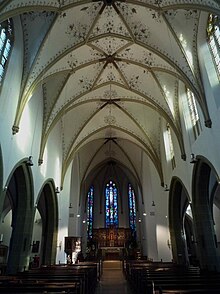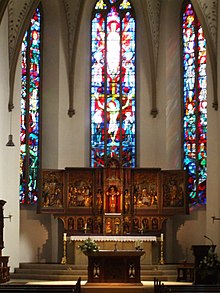Herzebrock Benedictine Convent
The Benedictine convent Herzebrock in Herzebrock-Clarholz ( Gütersloh district , North Rhine-Westphalia ) was founded around 860 as a canon monastery. In 1208 it became a Benedictine - Abbey converted. It existed until secularization in 1803.
It is still owned by the dynasty of Bentheim-Tecklenburg today .
founding
The founder of the Kanonissenstift was a Walburga, widow of an Eckhardus, who probably came from the Saxon family of the Ekbertines . The monastery was built on the family's own property and was under the protection of the Bishop of Osnabrück , who was entitled to contributions in kind. At the beginning, the monastery was equipped with 20 Meierhöfe. A son of Walburga gave him all of his property with the obligation of a lifelong support. Another son took over the bailiff's rights . The first abbess was Duda, a daughter of Walburga, who had been brought up in the Liesborn monastery . At first the monastery was consecrated to Maria.
The founding document, however, recognized the research as a forgery from the 11th century. However, it seems certain that a noble women's convent was founded in the 9th century, making it the oldest in the Osnabrück diocese.
Cannon pin
The foundation as a canon monastery around 860 is based on the application of the Aachen rule of 816 by the Institutiones Aquisgranenses . Around the year 900 the facility received a relic of Saint Christina from Bishop Egilmar von Osnabrück . Therefore the Church of St. Christina is consecrated. About a hundred years later, at the request of his wife Theophanu, Emperor Otto II gave it immunity and jurisdiction in 976. The convent was then free to choose the abbess and also had the right to appoint the bailiff. In 1096 a Herimanus was named as Vogt, who probably came from the family of the Counts of Werl . Later the right to free election was lost in practice. For a long time the office was in the hands of the Lords of Lippe . From 1465 the bailiwick rights were finally in the hands of the House of Bentheim-Tecklenburg-Rheda .
In 1069, Benno II tried to relocate the monastery to Osnabrück and to convert the facility into a monastery because of an alleged decline in customs . This failed. The convent managed to maintain a high degree of independence from the bishop.
Conversion into a Benedictine convent
Inside, she held fast to the canonical forms of life. This has been criticized by the regulated orders as irregularity and indiscipline. After 1208, together with the increasing severity of the conflicts with the diocese, this led to the bishop of Osnabrück Gerhard von Oldenburg , regardless of the imperial privileges, converting the monastery into a Benedictine monastery. The canonesses were not unprepared for this; some had already materially prepared for leaving the community.
The sister of Bishop Beatrix von Oldenburg became the first abbess. At this time, the abbess also received the spiritual jurisdiction that had previously been with the archdeacon in Wiedenbrück . Nevertheless, all in all, Herzebrock's independence was ended and a strong dependency on the diocese took its place. In the community itself, the position of the abbess in relation to the other members of the convent was strengthened. The far-reaching encroachment against all rights was possible not least because the bailiffs from the House of Lords to Lippe did not oppose the move, but even saw advantages in it.
Crisis in the late Middle Ages
The community was badly affected by a fire disaster in 1313 and the buildings almost had to be completely rebuilt. In 1419 the indulgence for pilgrimages to the Christian relic was granted. The faithful who made pilgrimages to Herzebrock on the feast of St. Christina, gave the church a gift and contributed to the maintenance of the convent, received indulgences for a hundred days.
In the 15th century the community suffered from the wars between the Lords of Lippe and the Counts of Tecklenburg. Parts of the monastery property fell desolate. Due to the lack of protection, the monastery lost numerous goods. The unlawful appropriation of monastery property could not be put to an end even by an instruction from Pope Nicholas V. During this time the community lived in great poverty. But life in Herzebrock also deteriorated in spiritual terms. Monastic poverty had given way to individual property formation.
Monastery reform
After 1459, the abbess Sophia von Stromberg (1426–1463) began reforming monastic life. She encountered considerable resistance in the Convention. Help for reform also came from outside. Sophia von Münster (1463–1500), who had also come from another convent, continued the reforms. One prerequisite was overcoming the material crisis. It was possible, in particular through the procurator of the monastery Johann von Hamm, to organize the economic situation.
In 1467 the community joined the reform movement of the Bursfeld Congregation . While most of the other women's monasteries only became part of the congregation by submitting to the supervision of a male monastery, Herzebrock succeeded in being accepted as an independent member. In 1475 the parish of Herzebrock was subordinated to the monastery. The income from the church thus also benefited the monastery. The upswing associated with the reform can be seen in the manuscripts created in the monastery at the turn of the 15th and 16th centuries. Mystical texts, prayers and devotions were written in Low German. Herzebrock became a focus of the Benedictine reform. From here, other monasteries were reformed. In spiritual and economic terms, this time was the last high point in the history of the monastery.
Time of the reformation
In 1543 the Reformation was inserted into the community by Vogt Cord von Tecklenburg. Even Franz von Waldeck as bishop of Osnabrück has operated a proreformatorische policy. The abbess Anna von Ascheberg (1533 to 1564) succeeded with skill and diplomacy in enabling the convent to keep the previous rite. After the defeat of the Protestants in the Schmalkaldic War , Franz von Waldeck was forced to return to the old church. As early as 1547, the community also returned to Catholicism. The disagreements with the Counts of Tecklenburg ended in the Bielefeld settlement of 1565. The monastery paid a high price for this, as it had to recognize the rule of the Tecklenburger.
Compared to other women's monasteries of the time, the religious and moral conditions in Herzebrock were only slightly affected by signs of decay.
17th and 18th centuries
During the Thirty Years War the monastery was looted and robbed several times. In times of danger the community fled to Wiedenbrück, where the convent owned a house. After the end of the war the economic situation improved again and new buildings were erected under Abbess Anna Magdalena von Schüren (1695 to 1723). In the 17th century, too, visitors expressed certain points about the nuns' way of life, but these did not go as far as in comparable monasteries.
In the 18th century the interest in the own past increased. The procurator Matthias Becker wrote a history of the monastery. A cycle of paintings on the history of the monastery was also created.
Secularization followed in 1803 and the religious order was quartered in the Bosfeld house near Rheda-Wiedenbrück . The Herzebrock Monastery and the Bosfeld House are still owned by the Princely House of Bentheim-Tecklenburg today .
Buildings and equipment
A first church was made of wood. A Romanesque successor building was built in stone. The west tower of today's church dates from the Romanesque period (around 1200). Around 1474, the single-nave nave and the choir with four longitudinally rectangular yokes in the late Gothic style were rebuilt. The yokes are painted with a colored tendril painting. The painting in the three western bays is particularly lush. A cloister was also built at this time . The rosary altar was part of the interior. Parts of the altar, which was later dismantled, are in the Kunstmuseum Munster and the National Gallery in London, they are attributed to an unknown master .
Between 1696 and 1703, abbey and convent buildings were rebuilt in the baroque style.
After the secularization, various buildings were demolished. In 1900 the cloister was demolished. A year later, the church was expanded into a three-aisled basilica. The substance of the existing building was interfered with. Restoration work was carried out in 1958. The monastery garden was reconstructed at the beginning of the 21st century. Today there is a small museum in the buildings. The remains of the cloister were monument of the month in Westphalia-Lippe in August 2010 .
The Prälatenweg connects the Herzebrock monastery with the Clarholz and Marienfeld monasteries .
Abbesses
- 2nd half of the 9th century: Duda
- 976: Sigiburg
- around 1080 − around 1097: Fretherun
- Gerswith
- Eila
- † around 1208: Goda
- 1208-1212: Beatrix of Oldenburg
- 1212 − after 1230: Floria
- around 1244 − around 1246/48: Alheidis von Rüdenberg
- around 1248-1270 / 80: Cunegundis
- around 1280–1283: Gertrudis
- around 1283–1329: Odradis
- 1329-1354: Mechthild von Solms
- 1355–1380: Elisabeth Wegansen
- 1380-1426: Elisabeth Korff
- 1422–1463: Sophia von Stromberg
- 1463–1500: Sophia von Münster
- 1500-1516: Sophia von Goes
- 1516–1533: Elisabeth von der Asseburg
- 1533–1564: Anna von Ascheberg
- 1564–1601: Anna von der Recke
- 1601–1615: Elisabeth Knipping
- 1615-1633: Margaretha Spyker
- 1634–1666: Maria von Amerungen
- 1666–1676: Theodora of Padevorth
- 1676–1695: Anna Catharina von Berswordt
- 1695–1723: Anna Magdalena von Schüren
- 1724–1729: Maria Felicitas von Alten
- 1729–1737: Maria Henrica von Plettenberg
- 1737–1741: Helena Dorothea von Donop
- 1741–1762: Maria Theresia von Wrede
- 1762–1789: Maria Barbara von Doetinchem
- 1789–1798: Josepha von Amelunxen
- 1798–1803: Eleonora von Grevingen
literature
- Paul Eickhoff: Brief History of the Herzebrock Monastery. Gütersloh 1876 (Online: ULB Münster )
- Heiko KL Schulze: Monasteries and monasteries in Westphalia. History, building history and description. A documentation . In: Géza Jászai (Ed.): Monastic Westphalia. Monasteries and monasteries 800–1800. Westfälisches Landesmuseum für Kunst und Kulturgeschichte, Münster 1982, ISBN 3-88789-054-X , pp. 365–366 (exhibition catalog, Münster, Westfälisches Landesmuseum für Kunst und Kulturgeschichte, September 26, 1982 - November 21, 1982).
- Edeltraud Klueting : The dioceses of the church province of Cologne. The Diocese of Osnabrück. Volume 1: The Kanonissenstift and Benedictine convent Herzebrock . de Gruyter, Berlin, 1986, ISBN 3-11-010566-7 ( Germania Sacra NF 21), partially digitized .
Web links
- Princely at Bentheim-Tecklenburg chancellery
- Parish Herzebrock - history of the monastery
- Document requests from the Princely Archive Rheda / Digital Westphalian Document Database (DWUD)
Coordinates: 51 ° 53 ′ 6.1 ″ N , 8 ° 14 ′ 43.2 ″ E






